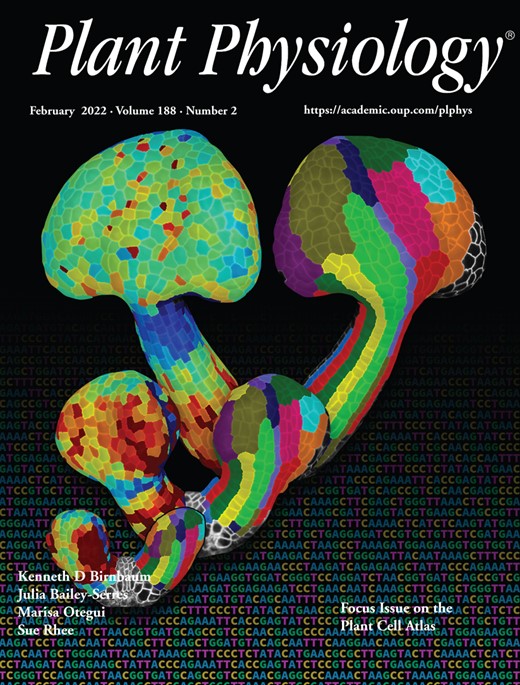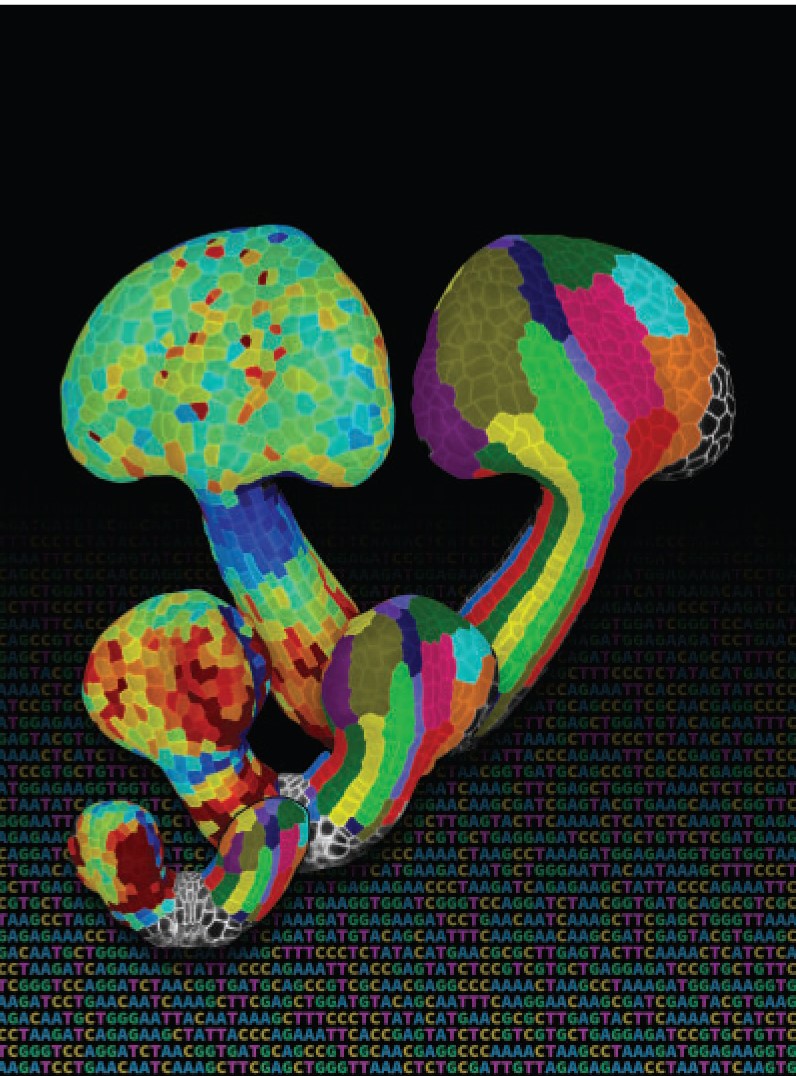
Cover image

Volume 188, Issue 2, February 2022
Focus Issue on the Plant Cell Atlas
Editorial
The Plant Cell Atlas: focusing new technologies on the kingdom that nourishes the planet
News and Views
Better NOT together: single-cell transcriptomic landscape of leaf tissues
Update
Cell Biology
Imaging plant cells and organs with light-sheet and super-resolution microscopy
Organizing your space: The potential for integrating spatial transcriptomics and 3D imaging data in plants
Combining spatial transcriptomics with 3D imaging technologies can demonstrate how genes are regulated across plant cells in a multi-dimensional space.
Plant Cell Atlas
Electron microscopy for imaging organelles in plants and algae
Systems and Synthetic Biology
To the proteome and beyond: advances in single-cell omics profiling for plant systems
Recent advances in single-cell proteomics for animal systems could be adapted for plants to increase our understanding of plant development, response to stimuli, and cell-to-cell signaling.
Toward synthetic plant development
Recent advances in our understanding of plant development and ability to control gene expression in plants may enable a new strategy for engineering plant form and function.
Single-cell genomics in plants: current state, future directions, and hurdles to overcome
With single-cell genomics having the potential to revolutionize the study of plant development, we address the current state, future directions, and hurdles to overcome.
Advances in enzyme-mediated proximity labeling and its potential for plant research
Innovation of new enzymes and methods makes proximity labeling an attractive tool for discovery of protein interactions and subcellular proteomes and broadens the spectrum of applications in plants.
Breakthrough Technologies, Tools, and Resources
Genes, Development and Evolution
Live-imaging provides an atlas of cellular growth dynamics in the stamen
Confocal live-imaging provides a quantitative atlas for analyzing cellular growth dynamics underlying stamen organogenesis in Arabidopsis thaliana.
An in situ sequencing approach maps PLASTOCHRON1 at the boundary between indeterminate and determinate cells
One-sentence summary: Simultaneous visualization of the expression profiles of ninety genes on sections through the maize shoot apex captures concurrent temporal sequence of transcriptional events within a spatial context.
Research Reports
Cell Biology
A biophysical model for plant cell plate maturation based on the contribution of a spreading force
The late-stage onset of an “areal” spreading and stabilizing force is essential for regular plant cell plate development and maturation.
Systems and Synthetic Biology
Towards resolution of a paradox in plant G-protein signaling
A mathematical model of the plant G-signaling switch agrees with recent data and suggests a role of 7-transmembrane regulator of G signaling in processing dynamical signals.
Research Articles
Biochemistry and Metabolism
REPRISAL: mapping lignification dynamics using chemistry, data segmentation, and ratiometric analysis
REPRISAL allows mapping lignification dynamics in plants based upon a combination of a monolignol chemical reporter strategy, parametric- and AI-based cell wall segmentation, and ratiometrics.
Cell Biology
X-ray microscopy enables multiscale high-resolution 3D imaging of plant cells, tissues, and organs
Lab-based X-ray microscopy allows high-resolution 3D imaging of intact plant samples over a wide range of sample types and sizes, filling the imaging gap between light and electron microscopy.
Live Plant Cell Tracking: Fiji plugin to analyze cell proliferation dynamics and understand morphogenesis
A pipeline and the plugin “Live Plant Cell Tracking” (LiPlaCeT) coupled to the publicly available ImageJ image analysis program allow 4D cell tracking and lineage analysis.
Shoot and root single cell sequencing reveals tissue- and daytime-specific transcriptome profiles
Analysis of Arabidopsis single cell transcriptome of roots (at end of day) and above ground tissues (at the end of day and the end of night) revealed marker genes, cell type differences, and similarities.
Genes, Development and Evolution
The genome and preliminary single-nuclei transcriptome of Lemna minuta reveals mechanisms of invasiveness
The genome and single-nuclei transcriptome of the Lesser Duckweed Lemna minuta provide preliminary evidence that tandem gene duplication and tissue-specific expression play roles in invasiveness.
Systems and Synthetic Biology
Single-cell transcriptomics sheds light on the identity and metabolism of developing leaf cells
Profiling young Arabidopsis leaves at the single-cell level enables mapping different cell populations, their development, and their sensitivity to mild drought.
Regular Issue Content
Editorials
Plant Physiology welcomes 13 new Assistant Features Editors
Integrating membrane transport, signaling, and physiology
News and Views
Suicide prevention for enzymes using continuous directed evolution
Engineering lignin: getting more from woody biomass
Last piece of the puzzle: defining client proteins of the NFU iron-sulfur transfer proteins in mitochondria
TINY ROOT HAIR 1: uncoupling transporter function in auxin-mediated gravitropism and root hair growth
Cool (soy)beans! SMV RESISTANCE CLUSTER7 protects plants against viruses
WRKYs work to limit root growth in response to shade
Banana ripening control: a non-canonical F-box protein links ethylene and ABA signaling
Update
Membranes, Transport and Bioenergetics
Posttranslational regulation of transporters important for symbiotic interactions
Regulation of transport proteins involved in mycorrhizal and rhizobial symbioses is best understood by incorporating what is known about regulation of related transporter proteins in the same family.
Breakthrough Technologies, Tools, and Resources
Genes, Development and Evolution
AnnoSINE: a short interspersed nuclear elements annotation tool for plant genomes
By integrating all known features of short interspersed nuclear elements (SINEs), AnnoSINE is a tool for both accurate and fast genome-scale SINE annotation in plant genomes.
systems and Synthetic Biology
Using continuous directed evolution to improve enzymes for plant applications
Continuous directed evolution using the yeast OrthoRep system is a powerful way to improve enzymes for use in plant engineering as illustrated by “plantizing” a bacterial thiamin synthesis enzyme.
Research Articles
Biochemistry and Metabolism
Exogenous chalcone synthase expression in developing poplar xylem incorporates naringenin into lignins
Expressing exogenous, apple-derived chalcone synthase in actively lignifying poplar xylem tissue results in less total lignin, improved saccharification rates, and incorporation of naringenin into lignins.
Protein lipoylation in mitochondria requires Fe–S cluster assembly factors NFU4 and NFU5
A pair of evolutionarily conserved proteins involved in iron–sulfur cofactor assembly have a specific role in lipoate biosynthesis for mitochondrial dehydrogenases.
pHBMT1, a BAHD-family monolignol acyltransferase, mediates lignin acylation in poplar
An enzyme from poplar, p-hydroxybenzoyl-CoA monolignol transferase (pHBMT1), adds ester-linked p-hydroxybenzoate moieties to lignin that can be readily hydrolyzed to release the aromatic compound.
Protection of photosystem I during sudden light stress depends on ferredoxin:NADP(H) reductase abundance and interactions
Altered location of a key enzyme involved in the post-photosystem I electron transport chain ameliorates damage to photosystem I during increasing light intensity.
Cell Biology
Potassium transporter TRH1/KUP4 contributes to distinct auxin-mediated root system architecture responses
A proton-coupled potassium transporter regulates root hair development and root gravitropism in a cell-file-specific manner by facilitating polar auxin transport in Arabidopsis root tips.
Voltage-dependent anion channel proteins associate with dynamic Bamboo mosaic virus-induced complexes
Mitochondrial voltage-dependent anion channel proteins associate with the dynamic Bamboo mosaic virus (BaMV)-induced complex and support BaMV accumulation in Nicotiana benthamiana.
CO2-dependent migration and relocation of LCIB, a pyrenoid-peripheral protein in Chlamydomonas reinhardtii
Algal chloroplast proteins undergo localization changes in response to CO2 concentrations, reflecting their physiological function in survival under fluctuating CO2 environments.
Auxin biosynthesis maintains embryo identity and growth during BABY BOOM-induced somatic embryogenesis
The BABY BOOM transcription factor induces YUCCA-dependent auxin biosynthesis during somatic embryogenesis to maintain embryo identity and development.
Rice Cell Division Cycle 20s are required for faithful chromosome segregation and cytokinesis during meiosis
Loss of all three rice Cell Division Cycle 20 genes caused male sterility, meiotic chromosome missegregation, aberrant spindle morphology, loss of meiotic cytokinesis, and disrupted tapetal function.
Ecophysiology and Sustainability
Nitrogen fertilization modulates beneficial rhizosphere interactions through signaling effect of nitric oxide
Moderate N fertilization enhances plant–beneficial rhizobacteria interactions and promotes plant N use efficiency, which is mediated by the signaling effect of denitrification-produced NO.
Can we harness digital technologies and physiology to hasten genetic gain in US maize breeding?
Big breeding data demonstrate that linking genomics and physiology through crop modeling-genomic prediction can hasten genetic gain and reduce the yield and water productivity gaps.
Genes, Development and Evolution
Tissue-specific transcriptomics reveal functional differences in floral development
Floret-specific differences in cell wall composition and sugar accumulation likely contribute to growth suppression in the lower floret of maize spikelets.
A NYN domain protein directly interacts with DECAPPING1 and is required for phyllotactic pattern
A NYN domain endoribonuclease interacts with proteins involved in mRNA decapping activation and is involved in the specification of phyllotactic pattern in Arabidopsis.
Reinforcement of CHH methylation through RNA-directed DNA methylation ensures sexual reproduction in rice
The increase of genome-wide CHH methylation through RNA-directed DNA methylation in anther and pistil is required for proper expression of developmental genes and fertility in rice
Interfered chromosome pairing at high temperature promotes meiotic instability in autotetraploid Arabidopsis
High temperature increases meiotic instability in newly generated autotetraploid Arabidopsis thaliana by interfering with chromosome pairing.
Membranes, Transport and Bioenergetics
A vacuolar hexose transport is required for xylem development in the inflorescence stem
ylem development and secondary cell wall formation partially depend on the control of cytosolic sugar availability, which is regulated by tonoplastic sugar transporters.
Vacuolar H+-pyrophosphatase HVP10 enhances salt tolerance via promoting Na+ translocation into root vacuoles
A barley vacuolar H+-pyrophosphatase plays a critical role in developing salt tolerance via the modulation of Na+ sequestration into root vacuoles.
PTOX-dependent safety valve does not oxidize P700 during photosynthetic induction in the Arabidopsis pgr5 mutant
A safety valve for electrons originating from Chlamydomonas efficiently functions in Arabidopsis but the PGR5 protein is still necessary to oxidize photosystem I during induction of photosynthesis.
Signaling and Response
A cluster of atypical resistance genes in soybean confers broad-spectrum antiviral activity
A soybean resistance gene cluster encoding atypical TNL-type R proteins might accelerate our understanding of molecular mechanisms contributing to plant immunity against viruses.
WRKY transcription factors and ethylene signaling modify root growth during the shade-avoidance response
Low red:far-red shade induces genes in roots regulated by WRKY transcription factors and ethylene, restricting primary and lateral root growth.
F-box protein EBF1 and transcription factor ABI5-like regulate banana fruit chilling-induced ripening disorder
The ethylene F-box protein interacts with abscisic acid-insensitive 5-like protein to regulate banana fruit starch and cell wall degradation, mediating cold stress-induced softening disorders.
bHLH11 inhibits bHLH IVc proteins by recruiting the TOPLESS/TOPLESS-RELATED corepressors
bHLH IVc proteins promote bHLH11 accumulation in the nucleus where it inhibits the transcriptional activation ability of bHLH IVc by recruiting TOPLESS/TOPLESS-RELATED corepressors.
Search for host defense markers uncovers an apple agglutination factor corresponding with fire blight resistance
A defense-inducible plant lectin aggregates bacteria by binding to surface bacterial polysaccharides, and accumulation of the lectin corresponds with enhanced resistance.
Rational design of Striga hermonthica-specific seed germination inhibitors
UNFERTILIZED EMBRYO SAC 12 phosphorylation plays a crucial role in conferring salt tolerance
Salt induces the phosphorylation of UNFERTILIZED EMBRYO SAC 12, enabling it to mediate the salt-overly-sensitive pathway and stomatal aperture movement to improve salt tolerance.














































